by Heidi Copeland | Aug 7, 2017
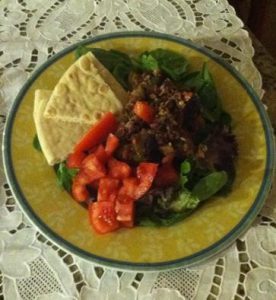 Can you believe it is that time of year already to sneak some zucchini on your neighbor’s porch! Honestly, it is a day to celebrate. And celebrate we should! It is the lucky neighbor who profits from the gardeners abundant harvest. Nonetheless, what can one do with all that zucchini?
Can you believe it is that time of year already to sneak some zucchini on your neighbor’s porch! Honestly, it is a day to celebrate. And celebrate we should! It is the lucky neighbor who profits from the gardeners abundant harvest. Nonetheless, what can one do with all that zucchini?
The late, Julia Child bestows the virtue of ratatouille in many of her books yet it seemed to take an animated rat in the award winning Pixar film to suggest ratatouille might be something to try. Really! Ratatouille, a traditional French Provençal stewed vegetable dish, originating in Nice is a mostly Mediterranean fare, however, we too have all the local produce to adapt this delicious dish.
How? What do you need? Ratatouille can be made just the way you like it but start with the basics: onions, eggplant, zucchini, garlic, tomatoes, red, green or yellow peppers, mushrooms, and fresh or dried herbs and a pinch of salt and pepper.
Ratatouille is typically served as a side dish, but may also be served as a vegetable soup, or a meal on its own accompanied by pasta, rice or bread. Ratatouille is good as a topping for your favorite grilled meat or fish, or as a filling in a simple omelet. Did I mention it can be added to quiche? Or stuffed into a pita pocket?
There is as much deliberation on how to make a traditional ratatouille as there is about how you eat it. Do you layer it and bake it? Is it sautéed? Is it simmered? Is it eaten as a side dish, a main dish or a sandwich filling? I’ve tried them all and even found success using a slow-cooker.
Try your hand at this simple yet elegantly adaptable vegetable dish.
The provided very basic recipe can be adapted to suit your personal/regional taste. Don’t like eggplant? Leave it out! Have a lot of okra or yellow squash? Add it! Like olives, nuts or raisins? Add them to your portion. Rather not use vegetable oil? Don’t! Want to cover it in your favorite spicy olive oil? Do you have some extra zucchini? I think you get the picture.
Ratatouille does not have to look like the vibrant Pixar version yet, it is still going to garner up gracious comments and acknowledgements from those you love and cook for. Whip up your version to savor today!
Ratatouille
Ingredients:
2 Tablespoons any kind of oil
4 medium onions, chopped – any color, any kind
2 medium eggplant, cut into 3/4-inch cubes
4 garlic cloves, minced
6 medium zucchini, cut into 1-inch cubes
2 large green, red or yellow bell pepper seeded and cut in 1” cubes
8 to 10 ripe tomatoes, peeled, seeded coarsely chopped (or use a can of fire roasted diced tomatoes)
3 fresh thyme sprigs (or to taste)
1 fresh rosemary sprig (or to taste)
1 dried or two fresh bay leaves
1/2 tsp. salt
1/2 tsp. freshly ground pepper
Directions:
In a BIG pot over medium heat, warm the oil. When it is hot, reduce the heat to medium, add the onions and sauté until translucent, about 2 minutes. Add the eggplant and garlic and sauté, stirring often, until the eggplant cubes are slightly softened, 3 to 4 minutes.
Add the zucchini and bell pepper and sauté, stirring and turning, until softened, 4 to 5 minutes more. Add the tomatoes, thyme, rosemary, bay leaf, salt and pepper, and stir and turn for 2 to 3 minutes more.
Cover, reduce the heat to low and cook, stirring occasionally, until the vegetables are soft and have somewhat blended together, about 60 minutes. (slow cooker at least 4 hours on high)
Remove from heat. Garnish with minced fresh basil. Transfer to a serving bowl and serve hot, at room temperature or cold. Serves at least 10.
by Pam Allen | Aug 5, 2017
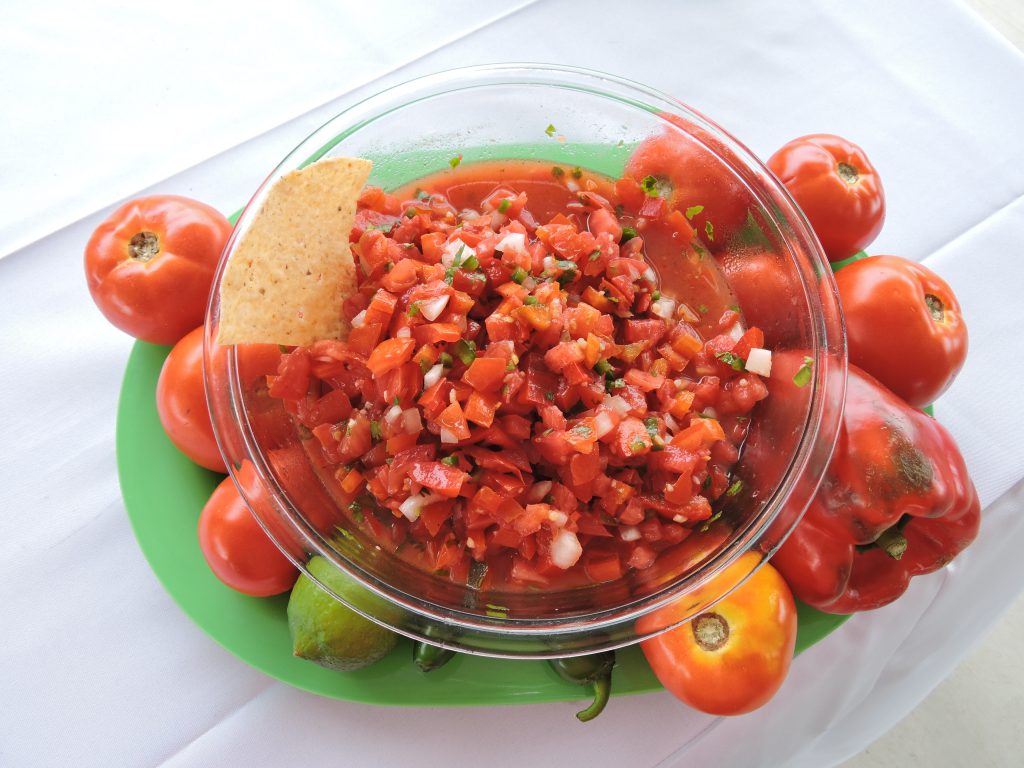 Tomatoes are abundant this time of year and you have many options to buy local and fresh. Tomatoes are one of the most popular home garden vegetable to grow and should now be providing the home gardener with fresh ripe bounty from now until summers end. Our local farmer’s markets are also selling tomatoes home grown and in many colors like deep red, bright yellow and green. Our climate is great for growing tomatoes. In fact, Florida is the nation’s largest producer of fresh tomatoes.
Tomatoes are abundant this time of year and you have many options to buy local and fresh. Tomatoes are one of the most popular home garden vegetable to grow and should now be providing the home gardener with fresh ripe bounty from now until summers end. Our local farmer’s markets are also selling tomatoes home grown and in many colors like deep red, bright yellow and green. Our climate is great for growing tomatoes. In fact, Florida is the nation’s largest producer of fresh tomatoes.
Nutritionally, tomatoes are packed with vitamin C and A. Low in calories and high in flavor, this succulent vegetable is a favorite all year long. Tomatoes are great served sliced and also in cooked dishes. Tomatoes should be stored at room temperature away from direct sunlight. Ripe tomatoes should be used within 3 to 4 days. For best flavor, do not refrigerate. Ripe tomatoes will give slightly to gentle pressure
If you want to preserve the summer’s tomato bounty, try your hand at canning. Remember to use USDA recommended practices for safety and long term quality. For a complete listing of how to safely can tomato products you will find the USDA guide here: http://nchfp.uga.edu/publications/usda/GUIDE03_HomeCan_rev0715.pdf
Farm Fresh Salsa
Fresh salsa is a low-fat, low sodium, treat that is packed with flavor and essential nutrients. Adjust the salt and oil to your taste and diet.
Ingredients:
6 medium ripe tomatoes, chopped
4 garlic cloves, minced
1 ½ seeded and minced jalapenos
1 red bell pepper, finely dices
½ red onion, finely chopped
1 Tablespoon olive oil
1 lime, juiced
Chili Powder, salt and pepper, to taste
Fresh scallions, cilantro or parsley, to taste
Directions:
In a bowl, combine all ingredients. Place in refrigerator for up to 12 hours for flavor infusion. Serve with your own baked chips.
Baked Tortilla chips
1 package medium or large tortillas
Cooking Spray
Salt to taste
Directions
Preheat oven to 375˚ F
On a cutting board cut tortillas into 8 – 12 pieces using a pizza cutter.
Place aluminum foil on 2 or 3 baking sheets.
Place tortillas pieces in a single layer on a cookie sheet.
Lightly coat tortillas with cooking spray on both sides.
Sprinkle tortilla pieces with salt to taste – or with salt-free alternative for dietary needs.
Place in oven and cook 10-15 minutes until crisp.
by Laurie Osgood | Dec 3, 2016
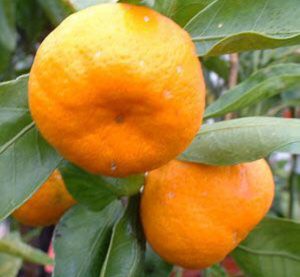 It’s the fall season, and Satsumas are hitting the shelves at your local grocery store. Satsumas are a seedless variety of the mandarin orange, and are harvested during the fall and early winter. Satsumas are grown in the cool, sub-tropical areas of California, Florida, Alabama, Louisiana, Mississippi and Texas. Because of their thin skin, satsumas are sweet and easy to peel. Whether you are buying satsumas from your local grocery store, farmers market or roadside stand, it is very important to purchase all of your citrus from a reputable vendor.
It’s the fall season, and Satsumas are hitting the shelves at your local grocery store. Satsumas are a seedless variety of the mandarin orange, and are harvested during the fall and early winter. Satsumas are grown in the cool, sub-tropical areas of California, Florida, Alabama, Louisiana, Mississippi and Texas. Because of their thin skin, satsumas are sweet and easy to peel. Whether you are buying satsumas from your local grocery store, farmers market or roadside stand, it is very important to purchase all of your citrus from a reputable vendor.
Satsuma Trees:
Satsuma trees are small to medium in size, and can easily tolerate the cooler fall temperatures that the Florida Panhandle is known for. Satsuma trees are relatively easy to grow and make an attractive addition to your home landscape. Picking fresh fruit off of your own tree provides a much fresher, and cost efficient treat. Satsuma trees are best started in a container and then transferred into the ground. When choosing a spot to plant a satsuma tree, remember that citrus trees need full sun.
 “Before planting any new plants, you should always conduct a soil sample, to determine if there are any issues in the soil where you will plan the satsuma tree” said DJ Wiggin, Small Farms Agent with the Florida A&M University Extension Program in Gadsden County. If you would like to request a soil sample test kit, you should contact your local UF/IFAS Extension office.
“Before planting any new plants, you should always conduct a soil sample, to determine if there are any issues in the soil where you will plan the satsuma tree” said DJ Wiggin, Small Farms Agent with the Florida A&M University Extension Program in Gadsden County. If you would like to request a soil sample test kit, you should contact your local UF/IFAS Extension office.
Fruit Bearing Season:
Satsuma oranges have a relatively brief fruit bearing season, between October and December. This short season give the satsuma oranges their rich flavor. A few nights with temperatures that drop into the 40s, help improve their sweetness. However, the fruit of the satsuma tree should be picked promptly when ripe, because the heavy fruit could cause damage to some weaker limbs of the tree.
According to DJ Wiggins, “When properly stored, satsumas have a shelf life of several weeks”. Satsuma oranges can be juiced, eaten as a snack, or used in recipes, including Orange marmalade.
Recipe Source: Adapted from So Easy to Preserve, from the Cooperative Extension at The University of Georgia.
Orange Marmalade
Yields about 7 half-pint jars
• 4 cups thinly slices Orange Peel (about 6 large oranges or 32 Satsumas)
• 4 cups Orange Pulp, cut up (about 6 large oranges or 32 Satsumas)
• 1 thinly sliced Lemon (about 2 medium)
• 6 cups of Water
• Sugar (about 6 cups)
Directions:
To Prepare the Fruit- Add water and fruit together in a saucepan. Heat to simmer for 5 minutes. Cover and let stand 12 to 18 hours in refrigerator. Heat and cook over medium heat until peel is tender, about 1 hour. (Note: When peeling citrus fruits for marmalades, be sure to include some of the white membrane found just under the skin. This is where most of the pectin is located.)
To Make Marmalade– Sterilize canning jars. Measure fruit and liquid. Add 1 cup sugar for each cup of fruit mixture. Bring slowly to boil, stirring until sugar dissolves. Cook rapidly to the jellying point (25 minutes), stirring occasionally. Pour hot marmalade into hot, sterile ½ pint jars, leaving ¼ inch headspace. Wipe jar rims with a dampened clean paper towel and adjust lids. Process 5 minutes in a Boiling Water Canner.
Interested in Learning More about Canning Fruits and Vegetables? The Gadsden County Extension Program offers Water Bath Canning Classes throughout the year, to learn more, call us at (850) 875-7255.
Resources:
University of Florida IFAS Extension. The Satsuma Mandarin, Peter C. Andersen and James J. Ferguson, Revised November 2015
http://edis.ifas.ufl.edu/pdffiles/CH/CH11600.pdf
University of Alabama Extension, Satsuma Season: Enjoying the Christmas Orange, James Miles and Emma Sager, November 10, 2014
http://news.aces.edu/blog/2014/11/10/satsumaseason/
University of Georgia Extension: Citrus Fruit for Southern and Coastal Georgia, Krewer and Powell, Extension Fruit Specialists.
http://extension.uga.edu/publications/detail.cfm?number=B804
Recipe: Reynolds, Susan, Paulette Williams, Judy A. Harrison, and Susan J. Reynolds. So Easy to Preserve. Athens: Cooperative Extension Service, U of Georgia, College of Family and Consumer Sciences, College of Agricultural and Environmental Sciences, 2006. Page 218
The Institute of Food and Agricultural Sciences (IFAS) is an Equal Opportunity Institution authorized to provide research, educational information and other services only to individuals and institutions that function with non-discrimination with respect to race, creed, color, religion, age, disability, sex, sexual orientation, marital status, national origin, political opinions or affiliations. For more information on obtaining other UF/IFAS Extension publications, contact your county’s UF/IFAS Extension office.
U.S. Department of Agriculture, UF/IFAS Extension Service, University of Florida, IFAS, Florida A & M University Cooperative Extension Program, and Boards of County Commissioners Cooperating. Nick T. Place, dean for UF/IFAS Extension.
Coauthors:
Laurie Osgood, Family and Consumer Science Agent, UF/IFAS Extension, Gadsden County
DJ Wiggins, Small Farms Agent, Florida A&M University Extension, Gadsden County
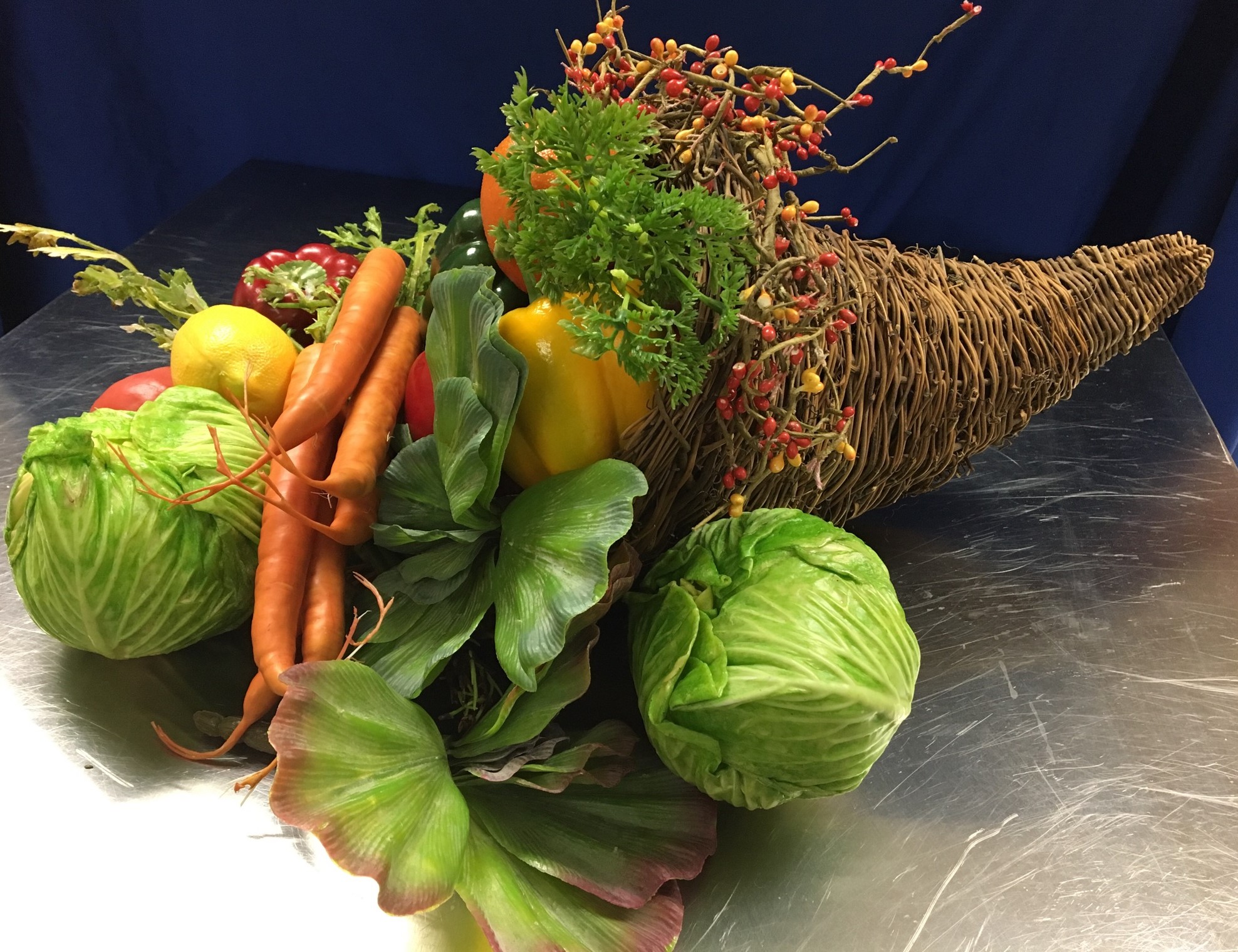
by Heidi Copeland | Nov 16, 2016
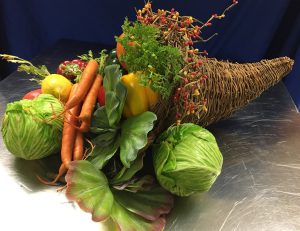 With Thanksgiving around the corner, it is only fitting to display a cornucopia. Not only is this horn of plenty a universal symbol of abundance, it is truly timely! Florida is plentiful with fresh produce this time of year. According to the Florida Department of Agriculture and Consumer Services (FDACS), avocados, bell peppers, carambola, cucumbers, eggplant, grapefruit, guava, mushrooms, oranges, passion fruit, peanuts, radishes, snap beans, squash, strawberries, sweet corn, tangerines, and tomatoes are in season now.
With Thanksgiving around the corner, it is only fitting to display a cornucopia. Not only is this horn of plenty a universal symbol of abundance, it is truly timely! Florida is plentiful with fresh produce this time of year. According to the Florida Department of Agriculture and Consumer Services (FDACS), avocados, bell peppers, carambola, cucumbers, eggplant, grapefruit, guava, mushrooms, oranges, passion fruit, peanuts, radishes, snap beans, squash, strawberries, sweet corn, tangerines, and tomatoes are in season now.
Locally, Red Hills Small Farm Alliance boasts an even greater array of foods grown within our community. Local growers are producing vegetables, as well as fresh herbs, fruits, and nuts! Foods growing in the community include arugula, Asian greens, eggplants, baby Pac Choi, kale, butter lettuce, watercress, elephant garlic, peppers (aji dulce, datil, habanero, banana, and serrano), salad turnips, mustard greens, okra, sweet potatoes, persimmons, Meyer lemons, satsuma/tangerines, ponderosa lemons, and herbs such as African blue basil, apple mint, ginger, oregano, garlic chives, lemon balm mint, and rosemary. Plus, the trees are full and American chestnuts and pecans have started falling in Monticello! It is a great year for local produce!
With the abundance of fresh seasonal produce available locally, it is easy peasy to build a healthy plate. MyPlate, the illustration of the five food groups that are the building blocks for a healthy diet, encourages the consumption of a variety of fruits and vegetables every day. In general, 1 cup of raw or cooked vegetables or vegetable juice or 2 cups of raw leafy greens can be considered as one serving from the Vegetable Group. Any vegetable or 100% vegetable juice counts as a member of the Vegetable Group. Vegetables may be raw or cooked, fresh, frozen, canned, or dried/dehydrated, and may be eaten whole, cut-up, or mashed.
Based on their nutrient content, vegetables are organized into 5 subgroups: dark-green vegetables, starchy vegetables, red and orange vegetables, beans and peas, and other vegetables.
Similarly, fruit is a building block, too. Overall, 1 cup of fruit or 100% fruit juice, or ½ cup of dried fruit can be considered as one serving from the MyPlate Fruit Group.
Plus, ½ ounce of nuts or seeds can be considered as a one ounce-equivalent from the Protein portion of MyPlate.
Alice Henneman, MS RDN, Extension Educator with the University of Nebraska Lincoln, suggests an easy way to incorporate a wide variety of vegetables into a daily diet is by making a casserole from what you have on hand (and even add a few nuts for depth of flavor). Why not delve into the Florida Fresh horn of plenty and whip up something good this month? Don’t forget to eat your fruit for dessert!
“Make-Your-Own” Casserole
Makes 6 servings
General Directions:
Select food(s) from each category or use your own favorites. Combine in a buttered 2 to 2 1/2 quart casserole dish. Cover and bake at 350 F for about 50 minutes to 1 hour or microwave using 50% power for about 15 to 30 minutes, rotating or stirring as necessary. Heat until steaming hot (165 F) throughout.
Starch: select ONE:
- 4 cups noodles or pasta cooked
- 2 cups cooked long-grain white or brown rice (or other grain)
Protein: select ONE:
- 2 cups cooked ground meat
- 2 cups cooked and diced chicken, turkey, ham, beef, or pork
- 2 cups chopped hard-cooked egg
- 2 cups fish or seafood, flaked (you can use canned)
- 2 cups cooked or canned beans (kidney, etc.)
Vegetable: select ONE or add a variety:
- 1 (10-oz.) package thawed and drained frozen spinach, broccoli, green beans, or green peas
- 1 16-oz. can green beans, peas, carrots, or corn
- 2 cups sliced fresh zucchini, bell peppers, mushrooms, snap beans, squash, sweet corn, or tomatoes
Sauce – select ONE:
- 2 cups white sauce or 1 can sauce-type soup (mushroom, celery, cheese, tomato, etc.) mixed with milk to make 2 cups
- 1 16-oz can diced tomatoes with juice
Flavor: select ONE or MORE:
- 1/2 cup chopped celery, 1/4 cup chopped onion, 1/4 cup sliced black olives
- 1 – 2 teaspoons mixed dried leaf herbs (basil, thyme, marjoram, savory)
- Fresh Garlic to taste
- Salt and pepper to taste
Topping – select ONE or MORE:
If desired, after heating, place on top:
- 2 tablespoons grated Parmesan cheese
- 1/4 cup shredded Swiss, Cheddar, or Monterey Jack cheese
- 1/4 cup buttered bread crumbs
- 1/4 to 1/2 cup canned fried onion rings
Return casserole with topping(s), uncovered, to oven for about 10 minutes or to microwave for about 2 minutes.
by Heidi Copeland | Apr 1, 2016
Can you believe Florida fresh fruits and veggies are supplied to 160 countries around the globe! Particularly abundant right now are the vegetables commonly referred to as cruciferous vegetables. (However, many scientists are starting to favor the term brassica vegetables over cruciferous vegetables) These nutritious veggies are ones that you will want to eat on a regular basis as they are bursting with both macronutrients and micronutrients.
The Florida Department of Agriculture and Consumer Services lists, cabbage, cauliflower, and radishes as being abundant in April for world production. Locally though, growers are turning out broccoli, cabbage, cauliflower, collard greens, kale, kohlrabi, mustard, rutabaga, turnips, bok choy, Chinese cabbage and arugula, as well as radishes.
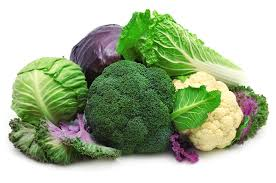 There are many simple ways to include cruciferous/brassica vegetables into your diet.
There are many simple ways to include cruciferous/brassica vegetables into your diet.
- Eat them raw! Raw vegetables can make a delicious, crunchy snack especially when served with a low-fat dip.
- Use in recipes! Make slaw, soup or salad, main dishes and even condiments!
- Substitute! Did you know steamed, mashed cauliflower can replace mashed potatoes? Or that coarsely grated cauliflower can replace rice? Folks have even substituted a cauliflower mixture as pizza crust! (okay, it might be a stretch but it does taste good)
Shopping, preparing and storing
- Cruciferous/brassica vegetables are typically inexpensive and can also be found year-round, fresh or frozen.
- Store raw, uncut and unwashed vegetables in the crisper drawer of your refrigerator for up to five days.
Cooking methods:
There are three factors affecting nutrient loss when you cook cruciferous/brassica vegetables:
- Temperature
- Time
- Amount of water used.
The cooking method that best retains nutrients is one that cooks quickly, heats food for the shortest amount of time, and uses as little liquid as possible.
- Using the microwave with a small amount of water essentially steams food from the inside out keeping more vitamins and minerals than almost any other cooking method. http://www.health.harvard.edu/
- Steam vegetables over a small amount of boiling water until a fork can just barely pierce it. (You can save the nutrients that are lost when steaming cauliflower by using the leftover water in a soup)
- Braise, bake or broil, stir-fry or sauté
Cruciferous/brassica vegetables are very unique in that the flower, the root, the stalk and even the leaves can be eaten depending on which plant you are eating.
Try a cruciferous/brassica vegetable a new way or even try a new cruciferous/brassica vegetable a traditional way!
Cauliflower Salad
(Or even use a combination of cauliflower and broccoli and kohlrabi)
Ingredients
2 Tablespoons sliced or diced onion, red, green or white
1 head of cauliflower – including the tender stems, cut into small pieces (or even cut into small florets)
1 Tablespoon sugar
1 Tablespoon vinegar (red wine, white wine, apple cider, or rice wine)
¼ cup mayonnaise
½ cup dried cranberries (or favorite dried fruit)
Salt and pepper to taste
In a large bowl, whisk the sugar, vinegar and mayonnaise together. Season with salt and pepper. Toss in the onion, cauliflower and cranberries and stir until well coated. Eat it right away or savor for a few days.
http://www.freshfromflorida.com/content/download/16796/269931/04April.pdf
 Can you believe it is that time of year already to sneak some zucchini on your neighbor’s porch! Honestly, it is a day to celebrate. And celebrate we should! It is the lucky neighbor who profits from the gardeners abundant harvest. Nonetheless, what can one do with all that zucchini?
Can you believe it is that time of year already to sneak some zucchini on your neighbor’s porch! Honestly, it is a day to celebrate. And celebrate we should! It is the lucky neighbor who profits from the gardeners abundant harvest. Nonetheless, what can one do with all that zucchini?





